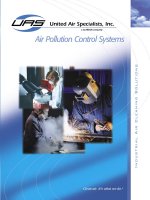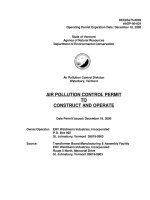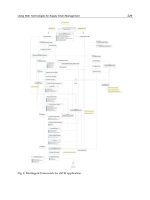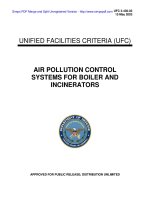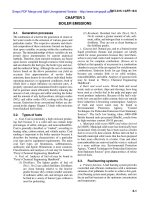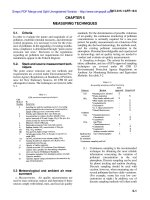Air Pollution Control Systems for Boiler and Incinerators Part 3 potx
Bạn đang xem bản rút gọn của tài liệu. Xem và tải ngay bản đầy đủ của tài liệu tại đây (131.32 KB, 10 trang )
TM 5-815-1/AFR 19-6
3-8
TM 5-815-1/AFR 19-6
3-9
(3) Using table 3-3, NOx emissions are given as (5) If the oxygen in the flue gas is estimated at 5
15 pounds/ton of coal. percent by volume, what is the dust con-
(a) 15 pounds/ton x ton/2000 pounds = .0075 centration leaving the boiler in grains/stand-
pound of NOx/pound of coal ard cubic foot (dry)?
(4) If particulate emission must be reduced to .2
pounds/MMBtu, the required removal effi-
ciency is determined as,
Using equation 3-1
TM 5-815-1/AFR 19-6
3-10
c. Sample Problem Number 2. A boiler rated at 50
MMBtu/hr burns fuel oil of the analysis shown below.
What are the estimated emission rates?
(1) Using table 3-4, particulate emissions are
given as [10(S) + 3] pound/I 000 gal, where (2) Using table 3-5 (footnote d), NO emissions
S is the percent sulfur in the fuel oil. are given as 120 pound/MCF of natural gas.
(2) Using table 3-4, SO emissions are given as
2
157S pound/1000 gal, where S is the percent
sulfur in the fuel oil. e. Sample Problem Number 4. A spreader stoker
(3) Using table 3-4, NO emissions are given as particulate emission rate from this boiler?
x
[22 + 400 (N) ] pound/1000 gal, where N is (1) Using table 3-6, the bark firing particulate
2
the percent nitrogen in the fuel oil. emission rate is given as 50 pounds/ton of
d. Sample Problem Number 3. A commercial boiler (13 x 10) pound/ton x 1000 pound/hr x
rated at 10 MMBtu/hr fires natural gas with a heating ton/2000 pound = 65 pounds/hr of
value of 1000 Btu/ft . What are the estimated particu- particulate from coal.
3
late and NO emission rates? (3) The total particulate emission rate from the
x
(1) Using table 3-5, particulate emissions are boiler is,
given as a maximum of 15 pound per million 50 pounds/hr from bark + 65 pounds/hr
cubic feet (MC F) of natural gas. from coal = 115 pounds/hr
x
fired boiler without reinjection burns bark and coal in
combination. The bark firing rate is 2000 pound/hr.
The coal firing rate is 1000 pound/hr of bituminous
coal with an ash content of 10 percent and a heating
value of 12,500 Btu/pound. What is the estimated
fuel.
50 pounds/ton x ton/2000 pounds x 2000
pound/hr = 50 pounds/hr of particulate from
bark.
(2) Using table 3-3, the coal firing particulate
emission rate for a heat input of 12.5
MMBtu/hr is 13A pounds/ton of fuel.
TM 5-815-1/AFR 19-6
4-1
CHAPTER 4
STACK EMISSION REGULATIONS AND THE PERMITTING PROCESS
4-1. Stack emissions c. Emission levels. One must file for a New Source
The discharge of pollutants from the smokestacks of
stationary boilers and incinerators is regulated by both
Federal and State Agencies. A permit to construct or
modify an emission source Will almost certainly be
required.
a. The emissions must comply with point source reg-
ulations, dependent upon characteristics of the point
source, and also with ambient air quality limitations
which are affected by physical characteristics of the
location and the meteorology of the area of the new
source.
b. The permitting procedure requires that estimates
be made of the effect of the stack emissions on the
ambient air quality. Predictive mathematical models
are used for arriving at these estimates.
c. Due to the time requirements and the complexity
of the process and the highly specialized nature of
many of the tasks involved, it is advisable to engage
consultants who are practiced in the permitting
procedures and requirements. This should be done at
a very early stage of planning for the project.
4-2. Air quality standards
a. Federal Standards — Environmental Protection
Agency Regulations on National Primary and Secon-
dary Ambient Air Quality Standards (40 CER 50).
b. State standards. Federal installations are also
subject to State standards.
4-3. Permit acquisition process
a. New Source Review. The state agency with juris-
diction over pollution source construction permits
should be contacted at the very beginning of the project
planning process because a New Source Review (NSR)
application will probably have to be filed in addition to
any other State requirements. A New Source Review
is the process of evaluating an application for a "Permit
to Construct” from the Air Quality Regulatory Agency
having jurisdiction.
b. Planning. Consideration of air quality issues very
early in the planning process is important because engi-
neering, siting, and financial decisions will be affected
by New Source Review. Engineering and construction
schedules should include the New Source Review pro-
cess which can take from 6 to 42 months to complete
and which may require the equivalent of one year of
monitoring ambient air quality before the review pro-
cess can proceed.
Review application if, after use of air pollution control
equipment, the new boiler or incinerator will result in
increased emissions of any pollutant greater than a
specified limit. Proposed modifications of existing
boilers and incinerators that will cause increases in
pollutant emissions greater than certain threshold levels
("de minimis" emission rate) require New Source
Review.
d. General determinants for steps required for per-
mitting. Steps required for a New Source Review
depend upon the location of the new source, charac-
teristics of the other sources in the area, and on discus-
sions with the State Air Pollution Control Agencies,
possibly the EPA, and how well one is current with the
changes in regulations and administrative practices.
Because of the constantly changing picture, it is usually
very beneficial to engage an air quality consultant to
aid in planning permitting activities.
e. Technical tasks. The principal technical tasks that
are required for the permitting effort in most cases may
be summarized as follows:
(1) Engineering studies of expected emission
rates and the control technology that must
be used.
(2) Mathematical modeling to determine the
expected impact of the changed emission
source.
(3) Collection of air quality monitoring data
required to establish actual air quality con-
centrations and to aid in analysis of air
quality related values. All technical tasks
are open to public questioning and critique
before the permitting process is completed.
f. New Source Review program steps. The steps
required in a New Source Review vary. However, it is
always required that a separate analysis be conducted
for each pollutant regulated under the Act. Different
pollutants could involve different paths for obtaining a
permit, and may even involve different State and Fed-
eral Agencies.
(1) Attainment or nonattainment areas. A con-
cern which must be addressed at the
beginning of a New Source Review is
whether the location is in a "nonattainment"
or “attainment” area. An area where the
National Ambient Air Quality Standards
(NAAQS) are not met is a "nonattainment"
area for any particular pollutant exceeding
the standards. Areas where the National
Ambient Air Quality Standards (NAAQS)
TM 5-815-1/AFR 19-6
4-2
that are being met are designated as an
"attainment" area. Designation of the area
as "attaining", or "nonattaining", for each
pollutant encountered determines which of
the two routes is followed to procure a
permit. Note that the area can be attaining
for one pollutant and nonattaining for
another pollutant. If this occurs one must
use different routes for each of the
pollutants and would have to undertake
both "preventation of significant
deterioration" (PSD) and "nonattainment"
(NA) analyses simultaneously.
(2) Attainment area. If the proposed source is
in an "attainment" area, there is a specified
allowed maximum increase, or "increment",
of higher air pollutant concentrations. The
upper limit of this increment may be well
below the prevailing National Ambient Air
Quality Standard (NAAQS). The
increment" concept is intended to "prevent
significant deterioration" of ambient air
quality. The new source might be allowed
to consume some part of the increment’‘ as
determined by regulatory agency
negotiations.
(3) Nonattainment area. If the proposed new
source is in a "nonattainment" area, it may
have to be more than off-set by decreases
of emissions from existing sources,
resulting in air cleaner after addition of the
new source than before it was added. In the
absence of pollutant reductions at an
existing source which is within
administrative control, it may be necessary
to negotiate for, and probably pay for,
emission reductions at other sources.
(4) Summary of permitting path. The steps
listed below present a summary of the
permitting steps:
(a) Formulate a plan for obtaining a con-
struction permit. It is usually advisable to
engage a consultant familiar with the per-
mitting procedures to aid in obtaining the
permit.
(b) Contact state regulatory agencies.
(c) Determine if the modification could
qualify for exemption from the New
Source Review process.
(d) Determine if the proposed facility will be
considered a "major source" or "major
modification" as defined by the
regulations.
(e) Determine if, and how, with appropriate
controls, emissions can be held to less
than "de minimis" emission rates for the
pollutant so New Source Review
procedures might be avoided.
(f) Consider the questions related to preven-
tion of significant deterioration and
nonattainment. If it is found the facility
will be a major source, determine for
which areas and pollutants you will have
to follow PSD rules. Determine possible
"off-sets" if any will be required.
(g) List the tasks and steps required for a per-
mit and estimate the costs and time incre-
ments involved in the review process.
Coordinate the New Source Review
schedule with the facility planning
schedule and determine how the New
Source Review will affect construction
plans, siting, budgetary impact, schedules
and the engineering for controls
technology.
4-4. Mathematical modeling
a. Modeling requirement. Air quality modeling is
necessary to comply with rules for proposed sources in
both attaining and nonattaining areas. Modeling is a
mathematical technique for predicting pollutant con-
centrations in ambient air at ground level for the spe-
cific site under varying conditions.
b. Modeling in attainment areas. Modeling is used,
under PSD rules, to show that emissions from the
source will not cause ambient concentrations to exceed
either the allowable increments or the NAAQS for the
pollutant under study. It may be necessary to model the
proposed new source along with others nearby to dem-
onstrate compliance for the one being considered.
c. Modeling in nonattainment areas. Modeling is
used to determine the changes in ambient air con-
centrations due to the proposed new source emissions
and any off-setting decreases which can be arranged
through emissions reduction of existing sources. The
modeling then verifies the net improvement in air
quality which results from subtracting the proposed
off-sets from the new source emissions.
d. Monitoring. Modeling is also used to determine
the need for monitoring and, when necessary, to select
monitoring sites.
e. Guideline models. EPA's guideline on air quality
recommends several standard models for use in reg-
ulatory applications. Selection requires evaluation of
the physical characteristics of the source and surround-
ing area and choice of a model that will best simulate
these characteristics mathematically. Selection of the
proper model is essential because one that greatly over-
predicts may lead to unnecessary control measures.
Conversely, one that under-predicts ambient pollution
concentration requires expensive retrofit control mea-
sures. Because of the subtleties involved, it is usually
advisable to consult an expert to help select and apply
the model.
TM 5-815-1/AFR 19-6
4-3
4-5. Monitoring 4-7. Factors affecting stack design
For a New Source Review, monitoring may be a. Design of the stack has a significant effect on the
required to obtain data which shows actual baseline air resulting pollutant concentrations in nearby ambient
quality concentrations. If monitoring is required, air. Stack emission dispersion analysis is used to deter-
prepare a monitoring plan that includes monitor siting, mine increases in local air pollution concentrations for
measurement system specifications, and quality specific emission sources. Factors which bear upon the
assurance program design. Once the plan is ready, it design of stacks include the following:
should be reviewed with the relevant agencies. — Existing ambient pollutant concentrations in
4-6. Presentation and hearings — Meteorological characteristics for the area
After a New Source Review application is prepared, it
must be reviewed with the appropriate agency. Often
a public hearing will be necessary and the application
will have to be supported with testimony. At the
hearing, all phases of work will be subject to public
scrutiny and critique.
the area where the stack will be located
— Topography of the surrounding area
b. Specific regulations having to do with stack
design have been promulgated by the EPA to assure
that the control of air pollutant shall not be impacted by
stack height that exceeds "good engineering practice”
or by any other dispersion technique. These regulations
have a direct bearing on the specific location and
height of a stack designed for a new pollution source.
TM 5-815-1/AFR 19-6
5-1
CHAPTER 5
MEASURING TECHNIQUES
5-1. Criteria standards. For the determination of possible violations
In order to evaluate the nature and magnitude of air
pollution, establish remedial measures, and determine
control programs, it is necessary to test for the exist-
ence of pollutants. In the upgrading of existing installa-
tions, compliance is determined through "point source
emission rate tests." Revisions to the regulations
regarding air pollution test requirements for federal
installations appear in the Federal Register.
5-2. Stack and source measurement tech-
niques
The point source emission rate test methods and
requirements are covered under Environmental Pro-
tection Agency Regulations on Standards of Perform-
ance for New Stationary Sources, 40 CFR 60 and
subsequent revisions. The techniques are listed in table
5-1.
5.3 Meteorological and ambient air mea-
surement
a. Measurements. Air quality measurements are
used to trace emission sources and determine if these
sources comply with federal, state, and local air quality
of air quality, the continuous monitoring of pollutant
concentrations is normally required for a one-year
period. Air quality measurements are a function of the
sampling site, the local meteorology, the methods used,
and the existing pollutant concentration in the
atmosphere. Personnel knowledgeable and experienced
in meteorology and air quality testing are needed to
conduct and evaluate air-quality measurements.
b. Sampling technique. The criteria for instrumen-
tation, calibration, and use of EPA-approved sampling
techniques are covered under 40 CFR 53
Environmental Protection Agency Regulations on
Ambient Air Monitoring Reference and Equivalent
Methods. See table 5-2.
(1) Continuous sampling is the recommended
technique for obtaining the most reliable
information concerning the variation of
pollutant concentration in the real
atmosphere. Discrete sampling can be used
for plume tracking and random checking.
Discrete sampling should be used with
caution, however, when measuring any of
several pollutants that have daily variations.
(For example, ozone has very low con-
centrations at night.) In addition, use of
discrete sampling methods will often result
TM 5-815-1/AFR 19-6
5-1
CHAPTER 5
MEASURING TECHNIQUES
5-1. Criteria standards. For the determination of possible violations
In order to evaluate the nature and magnitude of air
pollution, establish remedial measures, and determine
control programs, it is necessary to test for the exist-
ence of pollutants. In the upgrading of existing installa-
tions, compliance is determined through "point source
emission rate tests." Revisions to the regulations
regarding air pollution test requirements for federal
installations appear in the Federal Register.
5-2. Stack and source measurement tech-
niques
The point source emission rate test methods and
requirements are covered under Environmental Pro-
tection Agency Regulations on Standards of Perform-
ance for New Stationary Sources, 40 CFR 60 and
subsequent revisions. The techniques are listed in table
5-1.
5-3. Meteorological and ambient air mea-
surement
a. Measurements. Air quality measurements are
used to trace emission sources and determine if these
sources comply with federal, state, and local air quality
of air quality, the continuous monitoring of pollutant
concentrations is normally required for a one-year
period. Air quality measurements are a function of the
sampling site, the local meteorology, the methods used,
and the existing pollutant concentration in the
atmosphere. Personnel knowledgeable and experienced
in meteorology and air quality testing are needed to
conduct and evaluate air-quality measurements.
b. Sampling technique. The criteria for instrumen-
tation, calibration, and use of EPA-approved sampling
techniques are covered under 40 CFR 53
Environmental Protection Agency Regulations on
Ambient Air Monitoring Reference and Equivalent
Methods. See table 5-2.
(1) Continuous sampling is the recommended
technique for obtaining the most reliable
information concerning the variation of
pollutant concentration in the real
atmosphere. Discrete sampling can be used
for plume tracking and random checking.
Discrete sampling should be used with
caution, however, when measuring any of
several pollutants that have daily variations.
(For example, ozone has very low con-
centrations at night.) In addition, use of
discrete sampling methods will often result
TM 5-815-1/AFR 19-6
5-2
in economically unacceptable manpower
requirements. In these cases, sampling with
continuous instruments and recording on
data charts provides a lower cost solution.
(2) Air quality regulations require the measure-
ment of extremely small pollutant con-
centrations (1/100 of a part per million by
volume). Sensitive instruments capable of
detecting small concentrations are needed.
c. Sampling method for carbon monoxide. The fed-
eral reference method for measuring carbon monoxide
is the instrumental nondispersive infrared technique. A
typical instrument consists of a reference cell filled
with CO free air, and a sample, or detector, cell. The
difference in transmittance of infrared radiation passing
through the sample cell and the reference cell is sensed
by a photon detector. The difference is a measure of
the optical absorption of the CO in the sample cell and
is proportional to the CO concentration in the sample.
The signal from the detector is amplified and used to
drive an output meter as a direct measure of CO
concentration. This method is precise and accurate.
d. Sampling method for sulfur dioxide. The West-
Gaeke sulfuric acid method is the Federal reference
method for measuring sulfur oxides. The West-Gaeke
method is a discrete bubbler technique which involves
bubbling ambient air through an impinger for 24 hours.
Sulfuric acid is added to the absorber to eliminate
interferences from oxides of nitrogen. SO is collected
2
in a tetrachloromercurate solution. When acid bleach
pararosaniline is added to the collected SO together
2
with formaldehyde, a red-violet compound is formed
which is then measured spectrophotometrically. This
method is a discrete instrumental sampling method, but
may be modified for continuous use.
e. Sampling method for oxidants and ozone. The
instrumental-chemiluminescence method is the federal
reference method for measuring ozone. Upon mixing
ambient air and ethylene in the testing instrument,
ozone reacts with the ethylene to emit light. This light
is measured by a photomutiplier. If the air and ethylene
flow rates are constant, and the proportion of air and
ethylene therefore known, the resulting signal can be
related to ozone concentration. Analyzers are cali-
brated with a known ozone concentration.
f. Sampling method for nitrogen dioxide. The fed-
eral reference method for NO is the indirect measure-
2
ment of the concentration of nitrogen dioxide by
photometrically measuring the light intensity of wave-
lengths greater than 600 nanometers resulting from the
gas phase chemiluminescent reaction of nitric oxide
(NO) with ozone (O ).
3
g. Sampling method for total hydrocarbons. Gas
chromatography flame ionization is the federal refer-
ence method of measuring total hydrocarbons.
h. Sampling method for particulates.
(1) Total suspended particulates. The high
volume air sample is the federal reference
method for measuring total suspended
particulates. Air is drawn (at 40 to 60
ft /min) through a glass fiber filter by means
3
of a blower, and suspended particles having
an aerodynamic diameter between 100 and
1.0 micron are collected. The suspended
particulate is calculated by dividing the net
weight of the particulate by the total air
volume samples and is reported in ug/m .
3
(2) Coefficient of haze (C OH). A few states
have standards for a particulate measurement
called the coefficient of haze. This measure-
ment is reported in units of COH/1000 linear
feet of sampled air. In this method, air is
drawn through a small spot on a circle of
filter paper until the equivalent of a 1000 feet
long column of air of the diameter of the spot
has passed through the filter paper.
Transmittance through this spot then serves
as a measurement of particulate material
collected on the filter. There are considerable
doubts as to the usefulness and true meaning
of COH data, since the transmittance
recorded is a function of the nature of the
particulate as well as the total weight
sampled.
(3) Dustfall (settleable particulates). Several
states have standards for the amount of par-
ticulate that settles out of the air over a given
length of time (one common unit is grams/
square meter/30 days). The method of
collection is generally the dust bucket. A dust
bucket is a 15-inch deep metal or plate con-
tainer with a 6-inch opening that is exposed
to the air generally for a period of one month.
Dust buckets should be partially filled with
distilled water (or antifreeze) which prevents
the transporting of dust out of the buckets by
strong winds. This water also acts as a wash
at analysis time. After evaporating the water,
the remaining material is weighed and the
residues are converted to the required units.
i. Traceable compounds. Test methods for com-
pounds other than those for which standards exist are
often useful in evaluating stack dispersion. If unusual
fuel additives are used, or if incinerators are used to
dispose of specialized materials, laboratory chemists
can often devise sampling methods to measure these
compounds in the atmosphere.
j. Ringelmann standards. Particulate matter such as
soot, fly ash, and droplets of unburned combustibles
present in exhaust gases tend to impart blackness or
opacity to a plume. It is assumed that the darker the
shade of gray or black, the greater the concentration of
particulate matter present in a plume. The Ringelmann
TM 5-815-1/AFR 19-6
5-3
Chart offers a set of standards with which to measure have a removable cover. On double wall stacks
the opacity of an effluent plume. By the comparison of sampling ports may consist of a 4-inch diameter pipe
the blackness of a plume to the blackness of a series of extending from 4 inches outside the stack to the inner
graduated light diffusers, a Ringelmann number corre- edge of the inner stack wall. Accessible sampling ports
sponding to a percent opacity can be assigned to the shall be provided and located so that the cross sectional
plume (see table 5-3). It should be noted that while area of the stack or flue can be traversed to sample the
Ringelmann numbers give a relative indication of flue gas in accordance with the applicable current
plume opacity, they bear no direct relationship to federal or state regulations for fuel burning equipment.
plume particulate loading. They should supplement but
not replace point-source emission tests. 5-5. Air pollution project contacts
5-4. Flue gas sampling ports
Sampling ports are approximately 4 inches in diameter, ment for compliance with regulatory standards.
extend out approximately 4 inches from the stack, and
U.S. Army Environmental Hygiene Agency (AEHA),
Aberdeen Proving Grounds, MD, may be contacted for
the respective service air pollution projects on the fol-
lowing:
a. Source testing to characterize pollutants for
design controls.
b. Consultation on test performance standards and
witnessing tests.
c. Testing of installed air pollution abatement equip-
